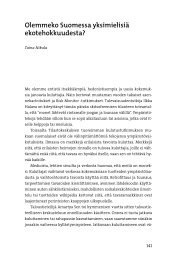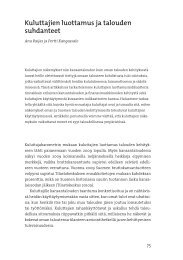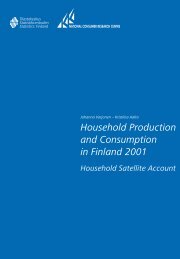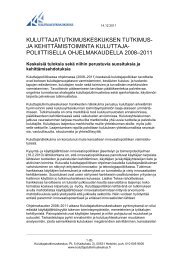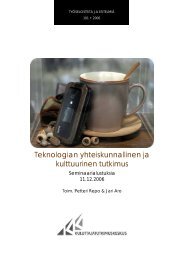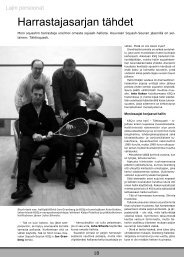Household Production and Consumption in Finland 2001
Household Production and Consumption in Finland 2001
Household Production and Consumption in Finland 2001
Create successful ePaper yourself
Turn your PDF publications into a flip-book with our unique Google optimized e-Paper software.
Summary<br />
The <strong>Household</strong> Satellite Account aims to make visible the non-market<br />
production of households, which is only partially covered <strong>in</strong> the National<br />
Accounts. All economic analyses depend on systematic data compiled <strong>in</strong> a given,<br />
structured format. However, no such data have been available for household<br />
production, so far. The purpose of the satellite account is to fill this gap.<br />
The <strong>Household</strong> Satellite Account measures <strong>and</strong> describes the value of the<br />
goods <strong>and</strong> services produced by households for their own f<strong>in</strong>al consumption. The<br />
ma<strong>in</strong> part of household production is outside the scope of GDP. Satellite Account<br />
is conceptually consistent with the core national accounts, <strong>and</strong> it enables to<br />
produce extended national accounts that <strong>in</strong>clude both core accounts <strong>and</strong><br />
household production. Such extended national accounts give a somewhat<br />
different picture of economic development than the core national accounts. They<br />
are of particular <strong>in</strong>terest <strong>in</strong> the analysis of long-term economic development or <strong>in</strong><br />
the comparison of levels of production <strong>in</strong> different economies.<br />
The F<strong>in</strong>nish <strong>Household</strong> Satellite Account has been compiled <strong>in</strong> compliance<br />
with Eurostat <strong>and</strong> SNA93 guidel<strong>in</strong>es. Some effort has also been made to<br />
further develop the Eurostat method. Accounts have been compiled for ten<br />
different types of households <strong>and</strong> for different pr<strong>in</strong>cipal functions of household<br />
production, i.e. provid<strong>in</strong>g hous<strong>in</strong>g, meals <strong>and</strong> snacks, cloth<strong>in</strong>g, care, <strong>and</strong><br />
volunteer work. Also shopp<strong>in</strong>g <strong>and</strong> travel related to unpaid work are shown<br />
separately. The F<strong>in</strong>nish <strong>Household</strong> Satellite Account describes household<br />
production <strong>in</strong> <strong>2001</strong>.<br />
<strong>Production</strong> not <strong>in</strong>cluded <strong>in</strong> the national accounts is valued by us<strong>in</strong>g the <strong>in</strong>put<br />
method. The data sources used <strong>in</strong> compil<strong>in</strong>g the account were Statistics F<strong>in</strong>l<strong>and</strong>’s<br />
Time Use Survey <strong>in</strong> 1999–2000, the <strong>2001</strong>–2002 <strong>Household</strong> Budget Survey, wage<br />
<strong>and</strong> salary statistics as well as National Accounts figures for <strong>2001</strong>.<br />
The total output value of household production <strong>in</strong> <strong>2001</strong> was 81.6 billion<br />
euros. Gross value added <strong>in</strong> household production was 62.8 billion euros, of<br />
which 13 per cent was <strong>in</strong>cluded <strong>in</strong> the national accounts. The GDP is<br />
<strong>in</strong>creased by 40 per cent <strong>and</strong> household consumption by almost 60 per cent<br />
when production excluded from the national accounts are <strong>in</strong>cluded <strong>in</strong> the<br />
figures. Among the various pr<strong>in</strong>cipal functions of household production, the<br />
highest gross value added figure was recorded for hous<strong>in</strong>g. Its share was 43 per<br />
cent of all household production. Meals <strong>and</strong> snacks accounted 27 per cent of<br />
household production.<br />
The volume of output varied <strong>in</strong> different types of households. Output was<br />
highest <strong>in</strong> families with small children <strong>and</strong> lowest <strong>in</strong> young s<strong>in</strong>gle-person<br />
households. Output <strong>in</strong>creased markedly with the age of the household’s<br />
reference person, both among people liv<strong>in</strong>g alone <strong>and</strong> couples. <strong>Household</strong><br />
structure <strong>and</strong> the age of household members had a greater impact on output<br />
than gross household <strong>in</strong>come.<br />
Extended national accounts time series will provide a valuable tool for<br />
monitor<strong>in</strong>g changes <strong>in</strong> economic development. In the future the aim is to<br />
compile household satellite accounts on a regular basis at a five-year <strong>in</strong>terval or<br />
more often us<strong>in</strong>g data from the national accounts, the <strong>Household</strong> Budget<br />
Survey <strong>and</strong> the Time Use Survey.<br />
10 Statistics F<strong>in</strong>l<strong>and</strong> National Consumer Research Centre




